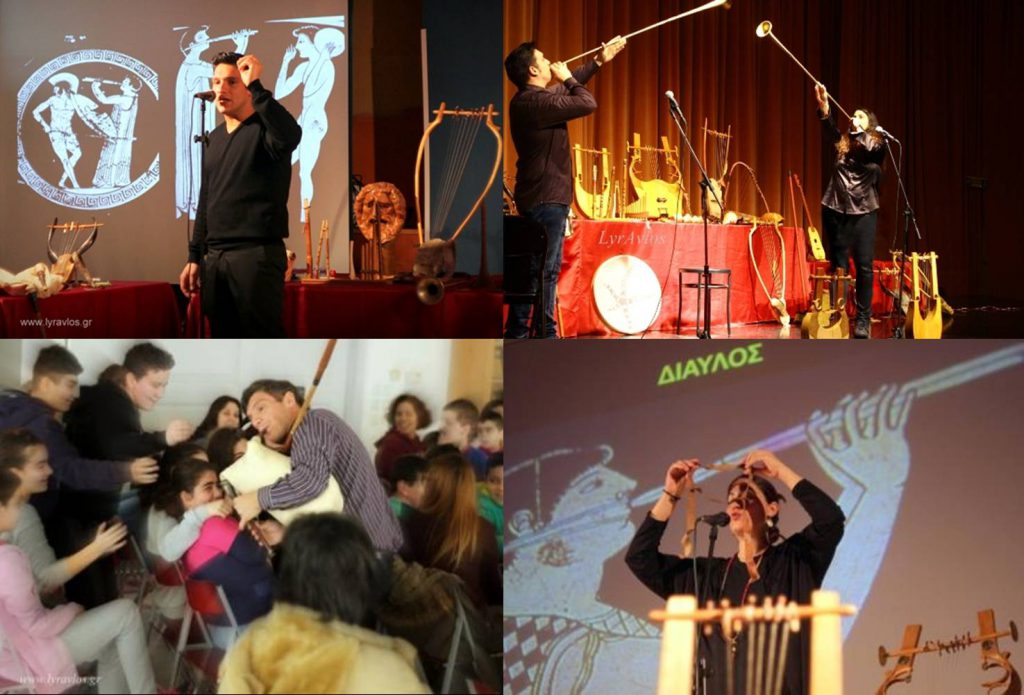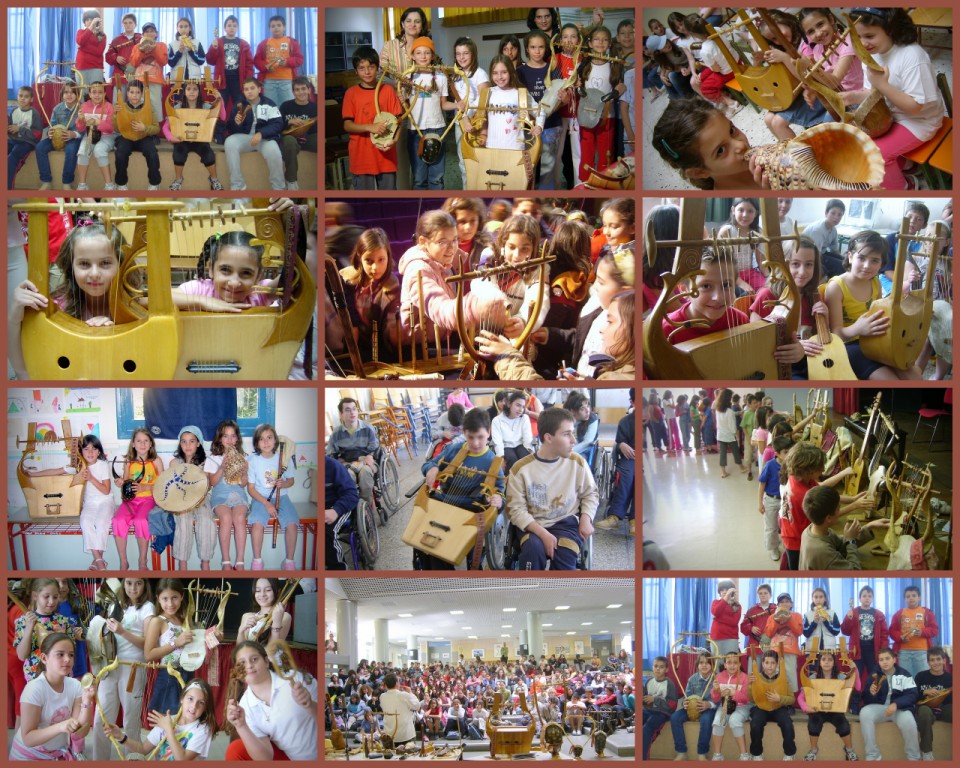The reconstruction of ancient Greek musical instruments and the revival of ancient Greek music are significantly assisting in the study of the multi-faceted Greek civilization and culture as well as Greek art. Furthermore, it enables the public to become acquainted with and achieve a better understanding of the Greek culture. Music was connected with the lifestyle and art in Ancient Greece. It enables people to approach and gain an understanding of the beauty and the essence in Ancient Greeks’ life and their way of thinking.
Greek art. Furthermore, it enables the public to become acquainted with and achieve a better understanding of the Greek culture. Music was connected with the lifestyle and art in Ancient Greece. It enables people to approach and gain an understanding of the beauty and the essence in Ancient Greeks’ life and their way of thinking.
THE PRESENTATIONS
The presentation involves the musical instruments as well as transparency slides projection with pictures of ceramics and other sources that reveal the importance of music and its role in Ancient Greece.
The musical instruments which are presented are totally functional and have been constructed to achieve the maximum degree of authenticity not only in terms of size and shape but also in terms of the materials used. A systematic, painstaking research in archeological sources has preceded the construction of the instruments in order to ensure scientific accuracy. It is worth mentioning that these instruments span from a period of approximately twenty centuries (from 1700 BC to 300 AD)
The ensemble’s main interest is to get the children involved in the presentation and help them approach the music as they listen to various instruments being played in various ways; children are even allowed to touch the instruments. The whole presentation is rounded off with a performance involving ancient Greek musical pieces.
The educational work of Lyravlos includes many presentations in schools of all grades, great universities in Greece (Ionian university, university of Ioannina, etc) and abroad (Sorbonne, Boston university, etc), participation in great and complex artistic events, as is the exhibition “Gifts of the Muses” in Bruxelles, in co-operation with the Greek Ministry of Culture, as well as the Belgium concerts in co-operation with the local Association of Teachers. (More on Lyravlos’ Appearances).
A special moment in this course of contact with youth should be mentioned, the excellent co-operation in 2005 with the Greek Ministry of Education, thanks to which Lyravlos reached many schools in Greece during an educational program that made a great impact (“extraordinary, charming presentation of ancient Greek instruments; their connection with the current musical reality, unique; I’m sure that it will be one of the most precious memories of our students; Thank you! – 82o elementary school of Athens – More opinions). Thousands of children so far have felt the rare experience of the contact with the Music of Ancient Greece, through programs and shows into which the children participated wholeheartedly.
Description of the shows
20 reconstructed authentic instruments, from the ‘divine’ Lyre of Apollo, to the melodious Flute, as well as their ‘continuations’ in the modern era through popular tradition – zournas, pipes of Thrace and the island-used tsampouna (heirs of the ancient askavlos) and daouli – wait for children to touch and know them. The children will listen to and enjoy the greatest surviving musical pieces of Antiquity, the tunes, rhythms and modes of the ancient Greeks, surviving through tradition and presenting the wealth and continuity of Greek Musical Tradition; they will touch the musical instruments and they will learn the history of their construction out of rare and authentic natural elements.
Wood from fir tree, box-wood, reed, intestines for the strings, tortoise shells, leather, fish glue and wooden nails, elements that arouse the imagination of children and open them to new fields of knowledge. A genuine and rare educational experience in a musical show designed especially for children. Yet this musical trip remains united with the superb Greek myths, escorted by slide presentations of vessel depictions revealing the musical life of ancient Greeks.
Panayiotis Stefos – the soul of all this complex work – is the person behind the unique musical show, communicating in a charismatic manner, activating children’s interest, having with him the members of Lyravlos that help him enliven the wealth of the Ancient Greek and Traditional Music.
Brief, yet comprehensive, references to the following subjects:
• Historical context.
• Musical and social life in Ancient Greece.
• Historical sources, Remains, Musical proof concerning ancient Greek music.
• Theoretical organisation of the ancient Greek music (pitch, scale, harmony, rhytmical organisation, musical character, notation).
• Acoustic examples using Pythagoras’ monochord.
The instruments presented are fully functional and constructed as closely as possible to the ancient dimensions, shape and materials. Their construction was based in meticulous study of the few surviving remnants of ancient instruments (e.g. flutes from Delos and Corinth, Lyres now to be found at the archaeological museums of Peiraeus, Athens and the British museum). Information was obtained also from hundreds of depictions of instruments in ancient vessels, sculptures, reliefs, coins and philological sources.
The instruments reconstructed and being presented are:
|
Strings:
|
Winds:
|
|
Percussion:
|
The instruments presented cover a period of 20 centuries (1700 b.C. to 300 A.D.) |
Lyravlos is especially concerned with the activation of the interest of children through not a museum-like but in a musical manner of approaching this subject. Besides the opportunity to touch the instruments, the children will also hear musical examples performed with each instrument. The examples are specially chosen to reveal all the possibilities of interpretation and the whole range of the instruments’ musical functionality.


